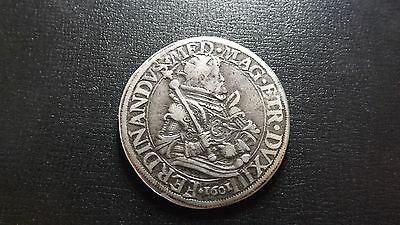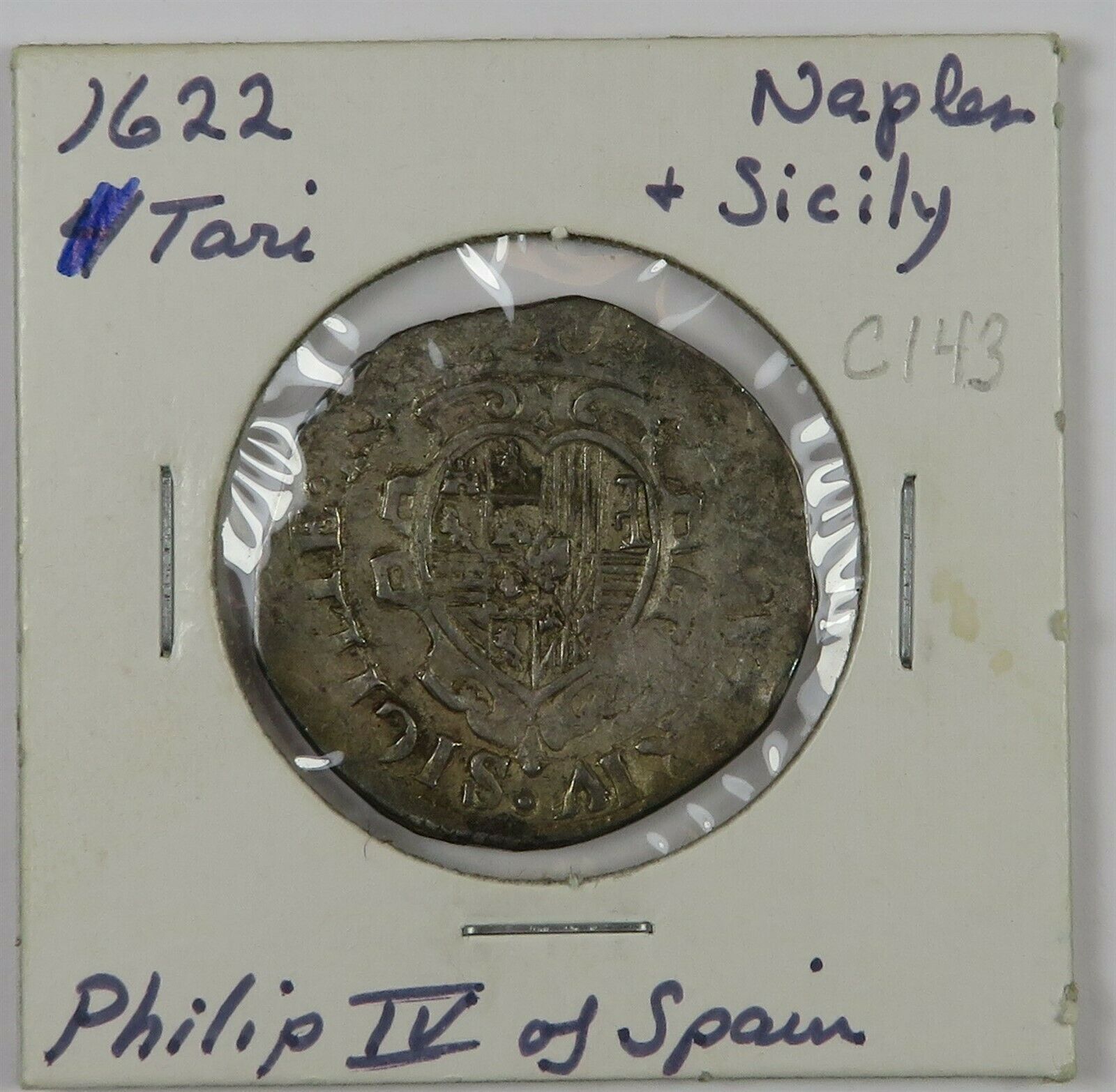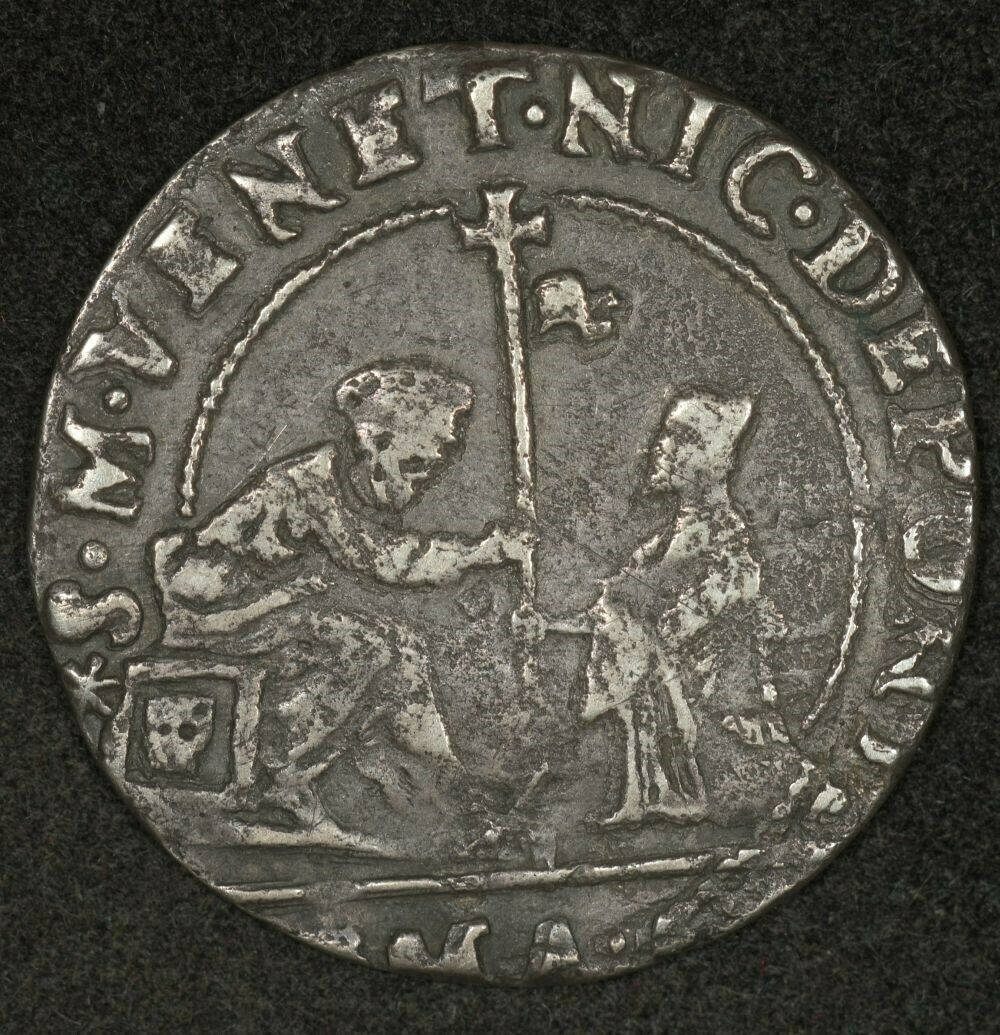-40%
1601 Italian States - Tuscany. Silver Tallero Taler Ferdinando I deMedici Italy
$ 517.43
- Description
- Size Guide
Description
Italian States -Tuscany
. Silver Tallero
of
Ferdinando I de Medici, 1587-1608
, Pisa (Italy), 1601
Lovely steel gray
silvery toning with original luster. 41 mm Diameter Weight: 28.42 Grams
Pisa, after a long career as an independent city state in the Middle Ages, fell under Florentine domination in Renaissance times. After the
Florentine republic collapsed, Pisa became part of the Grand Duchy of Tuscany, ruled by the Medicis until 1723.
The Grand Dutchy of Tuscany was a central Italian monarchy that ruled from 1569 to 1859 having replaced the Dutchy of Florence.
In th e15th Century the Medici Dynasty who ruled Florence annexed surrounding land to create the modern Tuscany.
Under the rule of the Medici family Tuscany became very prosperous and had unprecedented economic and military success which peaked
under Cosimo I and his sons. However the reign of Ferdinand I saw the start of Tuscany’s long economic decline.
The only further
advancement if it could be said to be such – was the Medici’s elevation to a royal status by the Holy Roma Emperor in 1691 however the
senior branch of the Medici family went extinct in 1737.
The Grand Duchy of Tuscany was a central Italian monarchy that existed, with interruptions, from 1569 to 1859, replacing the Duchy of Florence. The grand duchy's capital was Florence. In the 15th
Obverse
Description:
Radiate-crowned and cuirassed
armed half figure of Duke Ferdinand I de Medici facing right with long sceptre topped with a lily.
Half-figure of the Duke in
Obverse
Legend
:
•
FERDINANDVS * MED * MAG * ETR * DVX III * 1601
.
Reverse Description
:
Crowned
Medici shield containing arms, shield
superimposed on a
Maltese cross
or the Cross of St. John
Reverse Legend:
PISA INVETVSTAE MAIESTATIS MEMORIAM -.
Reference:
DAV #
4186
If for any reason you are not happy with your purchase we will refund your money back (see return policy)
Want to see more interesting Coins and Medals?
Check out my other listings
.
Ruler at time of minting
Ferdinando I
Grand Duke of Tuscany
Ferdinando was the fifth son (the third surviving at the time of his birth) of
Cosimo I de' Medici, Grand Duke of Tuscany
and
Eleonora di
Toledo
,
the daughter of Don Pedro Alvarez de Toledo, the Spanish viceroy of Naples.
He was made a
Cardinal
in 1562 at the age of 14 but was never ordained into the priesthood. At
Rome
, he proved an able administrator.
He
founded the
Villa Medici
in Rome and acquired many works of art (including the
Medici lions
), which he then brought back to
Florence
with him.
When his brother
Francesco I de' Medici, Grand Duke of Tuscany
died in 1587, Ferdinando succeeded as Grand Duke at the age of 38.
Ferdinando was from the
House of Medici who had
originated in the
Mugello region
of the Tuscan countryside, gradually rising until they
were able
to fund the
Medici Bank
. The bank was the largest in
Europe
during the 15th century, seeing the Medici becoming a
political dynasty
in
Florence
and
from this base extending their political influence
later in wider Italy and Europe.
Ferdinando fostered commerce and continued to gain great wealth through the Medici banks, which were established in all the major cities of
Europe.
Also the Grand Duke alone had the prerogative to exploit the state's mineral and salt resources, and the fortunes of the Medici were directly tied
to the
Tuscan economy.
Ferdinando also strengthened the Tuscan fleet, and it saw victories against pirates on the
Barbary
Coast
in 1607, and
against a superior
Turkish fleet
the following year.
Coat of arms of the Grand Duke of Tuscany
The "augmented coat of arms of the Medici,
Or, five balls in orle gules,was designed with
a larger ball incorporating of
the arms of France
-
three golden
lilies
which right was granted by
Louis XI
in 1465 in return for the assistance provided
by Florence during the dangerous rebellion of the French nobility
a
s a consequence of this grand concession by the
powerful sovereign the ball atop the Medici shield became blue with the fleur-de-lis inscribed in it.
The
ancient Romans
used similar insignias on their shields, but these identified military units rather than individuals and
during the first crusade such was
used to distinguish rang and protocol of the various troops.
By the 13th Century Coat of Arms had spread beyond their initial battlefield use to become a kind of flag or logo for
families in the higher social classes of
Europe, inherited from one generation to the next. Exactly who had a right to use
arms, by law or social convention, varied to some degree between countries
but basically it was a right only granted to
the aristocracy
A
coat of arms
is a unique
heraldic
design on an
escutcheon
(i.e.
shield
),
surcoat
, or
tabard
. A surcoat, and subsequently
a
coat of arms
was used by medieval
knights
to cover, protect, and identify the wearer. Thus these are sometimes termed
coat armory
Coinage of Florence and Tuscany
From A. D. 1189 to 1532 the coinage of Florence was autonmous. This coinage consisted of only the denaro until in the
thirteenth century, when the larger silver
grosso was added; and at about the same time (1252), Florence revived the
coinage of
gold, a metal which had not been coined in western Europe since the latter
part of the eighth century, and
struck the florin or fiorino d'oro. The financial and
commercial importance of Florence in Europe secured general
acceptance of the
new gold
coin; it was imitated at about 80 mints. The system of the florin, grosso,
and denaro, was
continued by the Medici as hereditary Gonfalonieri of the city.
The first duke of Tuscany, which included Florence, Alessandro de' Medici, intro
duced a silver coin still larger than
the grosso, called a testone, because it bore a
por
trait of the duke. This coin is said to have been engraved by Benvenuto
Cellini
(No. 99). The silver scudo (dollar size) was introduced in the reign of Cosimo I.
de' Medici, becoming known as
the francescone in reign of Francis II (1737-1765).
Tallero
Tallero, is the Italian thaler. It first appeared at Florence in 1570 under Cosmo I. De' Medici. Some of the earlier pieces and
their divisions have interesting portraits and
reverses.
Coins were minted with the name of several pre-unitary states. Tra questi i
duchi di Savoia
, la
repubblica di Ragusa
e il
granducato di Toscana
. Among these are the
dukes of Savoy
, the
Republic of Ragusa
and the
Grand Duchy of Tuscany
.
Tolerate
Tolerate
(tallero, tollore, tolloro, Thaler) is the name commonly used in
Tuscany
to indicate the
shield
coined by Grand
Duke
Ferdinand I
and his successors to use in trade
with the
East
.
The Medici family traded wool, silk and other luxury items from Asia; monopolized the alum trade (a fixative for dye);
precious metals needed to pay
spices
,
porcelain
and
silk
and other exotic goods from '
India
,
Indonesia
and other regions
of the '
Far East
.
The first Duke of Florence, Alessandro de' Medici (1533-36), used his portrait on the obverse and with John the Baptist
on the reverse of the coinage he had struck.
Ferdinand I struck copious coins and between 1587 and 1606 the Grand Duke appears to have had at least four coinages,
of which there are many sub-varieties. The first and
second (1587) exhibit him in his cardinal's dress and hat ; the third
(1596) omits the title in legend and alters the costume. The last (1601 -6) presents a crowned bust in armour
to right,
and Ferdinandvs " Med " Mag " Etr " Dvx " III "
Pisa seems to have been the usual mint; with Pisa forming part of the reverses’ legend.
The reverse shows a shield,
resting on a floriated cross which often served as substitute
for John the Baptist .
Pisa
mint
.
The old Pisa Mint was located inside the city wall,
near the
San Zeno
Gate
The
Province of Pisa
is located in central-western Tuscany,
covering a stretch of coastline, wide plains and rolling hills that include the
Colline Metallifere
to the South.
Pisa first belonged to the Longobard kingdom and later to the Carolingian empire. Already an important naval base in the
Roman era, from the 11th century Pisa intensified
its Mediterranean trade, with numerous victories of its fleet over Muslim
cities and ships.
The Mediaeval Era coincided with the height of its economic, political and artistic growth, to which the urban planning of
the old centre bears witness by its many religious and
civic buildings, its squares, its typical narrow alleys that run
perpendicular to the River Arno, the great trade route that for centuries represented the economic heart of the city.
The city walls, whose construction began around 1154-1155, were completed in the mid-14th century and today represent
an important part of the architectural heritage.
In 1406 Pisa was conquered for the first time by Florence, thus beginning a long period of profound crisis that ended only
with the political ascent of the Medici nobles. From the
second half of the 16th century there was a recovery characterized
by the development of the University, founded on the
orders of Lorenzo II Magnifico at the end of the 15th
century.
Cosimo I de' Medici and his successors renovated the aspect of the squares and churches, rendering Pisa the second capital
of Tuscany, until its annexation to the Kingdom of Italy
in 1861.
Terms of sale
Payment Policy
Only PayPal is Accepted.
Payment is expected within 48 hours. If you're bidding on other items, please let me know prior to issuing invoice so I can
try and ship together and pass on savings to you.
Shipping Policy
Best endeavour will be used to ship items on the next business day of receiving full payment.
Unless otherwise specified, I ship all coins in protective sleeves and enclose in bubble rapped envelopes to protect.
I absorb material and handling costs in my shipping rates.
I ship worldwide. Postage costs are flat.
I generate shipping labels from PayPal. Please make sure the information is correct with all details required to ensure
speedy arrival.
I ship from Australia and receipt will depend on a range of circumstances pertaining to the method chosen to ship.
International Shipping
Any Import duties, taxes and charges are the buyer's responsibility.
If unsure please check with your country's customs office to see if there are any additional costs prior to bidding/buying.
If there are any charges they will be normally collected by the delivering freight (shipping) company or when you pick the
item up. Please do not confuse them for my shipping charges.
Although it is an extra cost we recommend insurance on items that are over 0 and on any deemed non replaceable..
Returns Policy
We endeavour to provide accurate descriptions and details of the items for sale and any opinion of quality is just that- our
opinion and we give no warranties either expressed or implied as to our opinion especially respecting grades. This is
because grading can vary depending on many factors such as tone colour strike blemishes and overall combination of all
the before mentioned even between professional graders so please make your own examination from the photos so as to
make your own assessment.
If for whatever reason you are not completely happy with your purchase, please email me with your concerns within 7 days
and if they cannot be resolved, then so long as you return it to me in the same condition as it was sent I will give you a refund
of the sale cost of the item.
<div style="text-align:center"><a style="text-decoration:none" href="http://mostpopular.sellathon.com/?id=AC1379224"><img src="http://www.sellathon.com/Resources/Images/countercredit.gif" border="0"></a></div>











